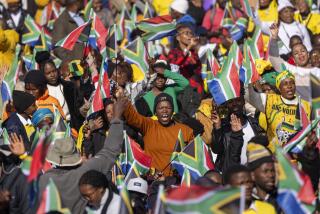South African Homeland of Bophuthatswana Balks at Rejoining Nation : Africa: Instead of being lured by the end of apartheid, homeland leaders seem more determined than ever to hang onto independence for their patchwork of seven separate tracts scattered across the country.
- Share via
MMABATHO, South Africa — The more things change in South Africa, the more they seem to remain the same in the black homeland of Bophuthatswana.
Fourteen years after declaring itself a nation, Bophuthatswana still is ignored by the world but refuses to return to South African rule.
Instead of being lured by the end of apartheid, its leaders seem more determined than ever to hang onto independence for their patchwork of seven separate tracts scattered across South Africa.
“The future position of . . . South Africa is still too uncertain,” President Lucas Mangope of Bophuthatswana told Parliament in April. “No responsible leader or government can be expected to walk blindly into a dispensation of unknown nature.”
South Africa carved out 10 black homelands in the 1960s, with the aim of making them independent and leaving the best parts of the country for the whites.
Four eventually became independent, but Venda, Ciskei and Transkei now want to return. Venda is in the far northeast, near the border with Zimbabwe. Ciskei and Transkei are on the southeastern coast.
Mangope fears that the next government will be dominated by the African National Congress, South Africa’s main black opposition group, which opposes the homeland concept and considers Mangope a corrupt puppet of the South Africans.
Among the senior ANC leaders is Peter Malebane-Metsing, who fled Bophuthatswana in 1988 after leading an unsuccessful coup against Mangope.
The ANC’s close alliance with the South African Communist Party strikes fear into Bophuthatswana’s capitalist soul.
During an interview in the homeland’s modern capital, Education Minister K. C. Sehume said that, while communism was in trouble everywhere, “Look at Mmabatho: People drive beautiful cars, live in beautiful homes.”
Government and business leaders see Bophuthatswana as an oasis on a troubled continent, an image that applies in Mmabatho and Sun City, the gambling resort.
Construction cranes swing through the skies, building luxury hotels and office buildings. The racial tension prevalent in South Africa’s big cities seems to melt away.
“What’s your sign?” a young black policeman asked a white woman, flirting across the color line in a manner almost unheard of in South Africa.
James Fields, a native of Dallas, Tex., arrived in 1981 to help manage a fund that invests people’s money for retirement. Fields, 33, is white. His wife, Pamela, is a black from the South African township of Soweto who moved to Bophuthatswana to attend school.
They were able to avoid much of the prejudice facing interracial couples in South Africa, where such relationships were illegal until 1985. In addition, Pamela Fields said, she could attend a university free from the political turmoil of South Africa.
Mangope cites wise money management and racial integration as examples of why Bophuthatswana thrives in relation to other homelands, but it had advantages from the start.
The South African government pumped millions of dollars into the homeland, hoping to make it a model for others. The seven pieces include rich platinum reserves and are suitable for producing enough cattle and maize to feed its 2 million people in a good year.
Bophuthatswana, commonly called Bop, remains far from self-sufficient despite this.
Aid from South Africa accounts for 27% of the 1991-92 budget and 80% of trade is with South Africa. The government says nearly 40% of the people work there and the number is expected to increase with the lifting of economic sanctions that drove many businesses out of South Africa.
Outside the air-conditioned comfort of Mmabatho’s offices and Sun City’s glittering casinos, shantytowns like those in South Africa’s impoverished black townships appear in the dismal desert landscape. Most of the well-off business leaders in Bophuthatswana are white South Africans or foreigners.
Perhaps the most vivid example of Bophuthatswana’s inability to fend for itself was the 1988 coup, which would have succeeded if South African soldiers had not intervened.
Critics of Mangope say corruption and nepotism keep him in power.
“If you are not known, then it is just too bad for you,” said Pupsey Sebogodi, leader of an anti-independence movement in Braklaagte village.
“But if you are famous somehow, by having a relative in the government or somewhere in important places, you are better off. Those are the people who say it is better for us to be in Bop than in the townships.”
Vocal criticism of this sort is rare in Bophuthatswana, where security forces are accused of silencing dissidents brutally.
Scores of Mangope’s opponents are in jail, most in connection with the coup. They have become a major obstacle to the South Africa’s attempt to begin talks with the ANC on a new constitution.
The ANC wants the political prisoners freed; South Africa says they are the homeland’s responsibility.
More to Read
Sign up for Essential California
The most important California stories and recommendations in your inbox every morning.
You may occasionally receive promotional content from the Los Angeles Times.














